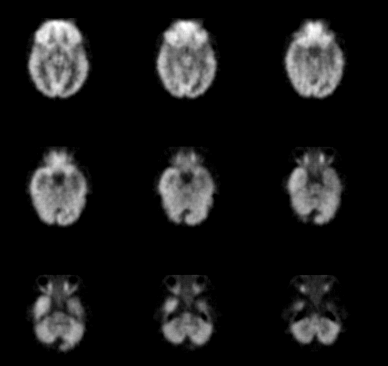Case Author(s): J. Philip Moyers, MD. and Farrokh Dehdashti, M.D. , 7/28/95 . Rating: #D3, #Q4
Diagnosis: epileptic focus left temporal lobe
Brief history:
12-year old boy with history of
complex partial seizures, poorly controlled with
medications.
Images:

transaxial slices through temporal lobe
View main image(pb) in a separate image viewer
Full history/Diagnosis is available below
Diagnosis: epileptic focus left temporal lobe
Full history:
12-year old right-handed boy who
is seen with chief complaint of uncontrolled seizures,
which first started at the age of approximately 15
monhts. Currently, his seizures are of a complex
partial type, described as a blank stare with
unresponsiveness, difficulty breathing, and aural/oral
automatisms and hand automatisms.
Radiopharmaceutical:
F-18 fluorodeoxyglucose
Findings:
PET brain study
demonstrates a focus of hypometabolism in the left
temporal lobe when compared to the right temporal
lobe. The remainder of the PET study is within
normal limits.
Discussion:
Complex partial seizures with a
temporal lobe focus are common among epileptic
patients. Imaging can be performed with CT, MRI, or
PET. MRI is superior to radiographs and CT in
identifying morphologic abnormalities in patients
with epilepsy. Small areas of gliosis or small AVMs
can be overlooked with CT examination. Also,
heterotopic gray matter may also be missed by CT
examination. A cause of complex partial seizures is
mesial temporal sclerosis. In this pathologic entity,
there is prominent hippocampal cell loss with atrophy
of the medial aspect of the temporal lobe involved. In
some patients with partial seizures, MRI may be
normal or demonstrates a smaller temporal lobe
without increased signal intensity on the side of the
lesion. Therefore, interictal PET studies are helpful
to evaluate for interictal cerebral metabolism. Studies
of cerebral blood flow, metabolism, and
neurotransmitter activity are felt to be more
promising than structural imaging in the evaluation
of patients with epilepsy who have negative or
unequivocal MRI. Clearly, measurement of regional
cerebral glucose metabolism has proved the most
useful in evaluation of patients for seizure surgery.
FDG-PET may avoid unnecessary invasive tests.
Most studies demonstrate interictal hypometabolism
in approximately 60-90% of patients with complex
partial seizures. The degree of hypometabolism on
the PET study is not related to the percentage of
neuronal loss and, the hypometabolic regions are
usually larger than the area of pathologic
abnormality. For example in the patient with mesial
temporal sclerosis where hippocampal cell loss is a
prominent feature, hypometabolism involved the
entire temporal lobe rather than just the medial
aspect in the region of the hippocampal gyrus. In
addition, hypometabolism may be seen in the
ipsilateral basal ganglia and thalamus. Both
qualitative and quantitative analysis of PET studies
can be used to lateralize the abnormal temporal lobe
for surgical resections, although it is unclear which
approach should be used.
In this patient, an MRI was performed which was
interpreted as normal. Possibly, the long-standing
changes of mesial temporal sclerosis may not have
had time in this young patient to form a structural
abnormality. This underscores the usefulness of PET
studies in the evaluation of seizure foci in patients.
with seizure disorder.
References:
1) Mazziotta JC, Gilman S. Clinical brain imaging:
principles and applications. Philadelphia, PA:
FA Davis Company, 1992.
2) Fisher RS, Frost JJ. Epilepsy. J Nucl Med
1991;32:651-659.
Followup:
A follow-up EEG suggests a left
temporal lobe seizure focus.
Major teaching point(s):
In the absence of an
abnormal hippocampus on MRI, FDG-PET may be
used to localize the abnormal temporal lobe.
ACR Codes and Keywords:
References and General Discussion of PET Brain (Nontumor) Imaging Studies (Anatomic field:Skull and Contents, Category:Organ specific)
Search for similar cases.
Edit this case
Add comments about this case
Read comments about this case
Return to the Teaching File home page.
Case number: pb001
Copyright by Wash U MO

